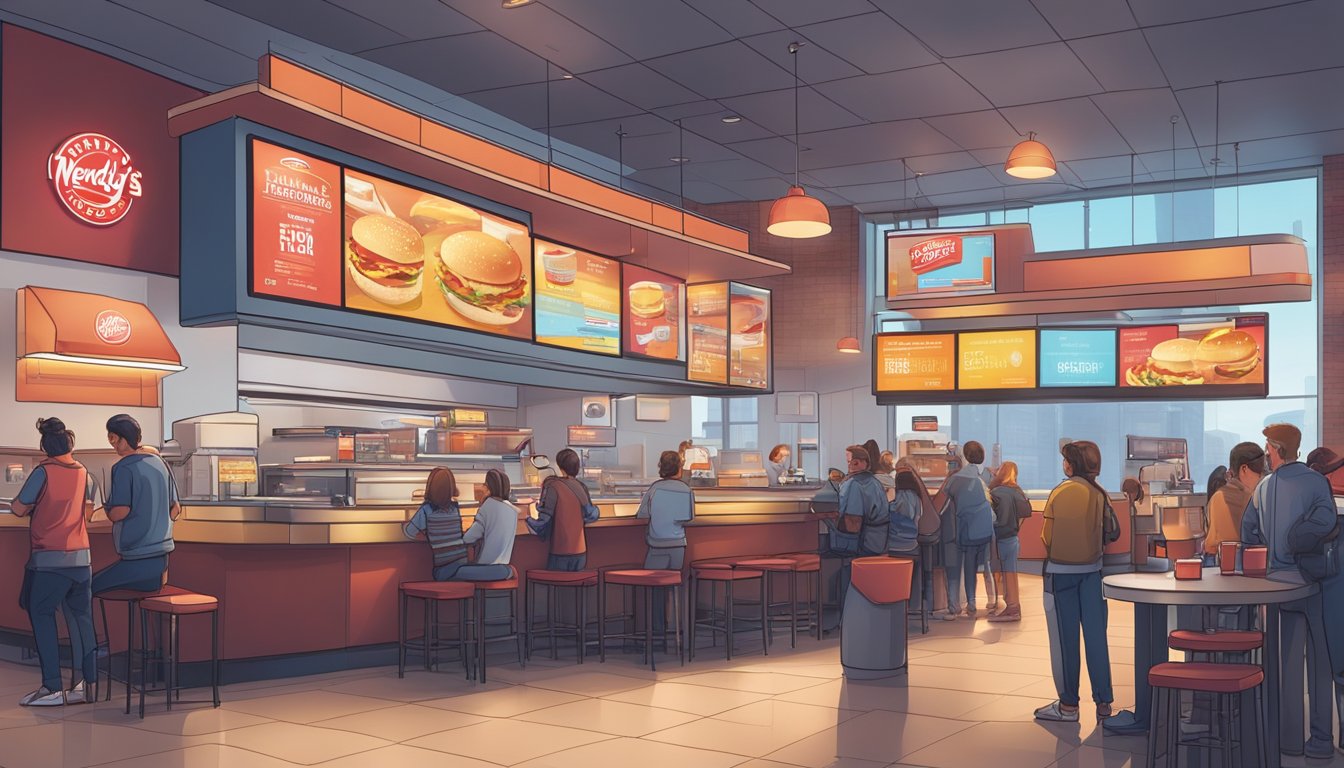Wendy’s breakfast menu has become a key driver of the company’s success since its introduction in 2020. The fast-food chain reported strong same-store sales growth, largely attributed to its morning offerings. Wendy’s emphasis on pick-up and delivery options, bacon-centric items, and social media engagement has contributed to the breakfast menu’s popularity.
As Wendy’s looks to the future, the company plans to invest $100 million to enhance its breakfast and digital capabilities. This investment signals a commitment to expanding and improving the breakfast experience for customers. Wendy’s has already demonstrated a willingness to innovate, introducing new items like the Breakfast Burrito and partnering with other brands to create unique offerings such as the Cinnabon Pull-Apart.
The fast-food chain also recognizes the importance of value in attracting breakfast customers. Wendy’s has implemented promotions like the 2 for $3 breakfast bundle, which has become a permanent fixture on the menu. This strategy, combined with ongoing culinary innovation, positions Wendy’s to continue growing its breakfast market share and challenging established competitors in the coming years.
Overview of Wendy’s Breakfast Strategy

Wendy’s has made significant strides in the breakfast market, focusing on menu innovation and customer experience. The company’s approach combines unique offerings with strategic marketing to carve out a competitive position.
Rise of the Breakfast Category
Wendy’s entered the breakfast category with renewed vigor in 2020. The move paid off, with the company reporting its strongest same-store sales in 15 years. Breakfast quickly became a key driver of growth for Wendy’s.
The breakfast menu’s success was attributed to several factors. These included an emphasis on pick-up and delivery options, popular bacon items, and effective social media marketing. Wendy’s capitalized on changing consumer habits during the pandemic.
By 2021, the breakfast daypart accounted for 7% of company sales. Same-store sales in the first quarter of that year showed a 6% increase, with projections reaching 10% for the full period.
Wendy’s Positioning in the Breakfast Market
Wendy’s has positioned itself as a strong competitor in the breakfast market through menu innovation and quality offerings. The introduction of items like Homestyle French Toast Sticks in 2022 demonstrated the company’s commitment to expanding its breakfast lineup.
The success of these new items led to international expansion, with the French Toast Sticks launching in Canada. Wendy’s strategy focuses on providing affordable, delicious options to attract and retain breakfast customers.
The company aims to grow its breakfast business by 10% to 20% annually. This goal translates to average weekly U.S. breakfast sales of $3,000 to $3,500 per location. Wendy’s continues to leverage its brand strength and marketing prowess to solidify its position in the competitive breakfast market.
Executive Insight

Wendy’s leadership has been instrumental in shaping the company’s breakfast strategy. Both current and former CEOs have provided crucial direction for this important daypart.
Leadership from CEO Todd Penegor
Todd Penegor led Wendy’s through its successful breakfast launch in 2020. He emphasized the importance of breakfast as a key growth driver for the company. Penegor focused on menu innovation and operational efficiency to ensure a smooth rollout.
Under his guidance, Wendy’s introduced popular items like the Breakfast Baconator and Frosty-ccino. These offerings helped differentiate Wendy’s breakfast from competitors. Penegor also prioritized marketing efforts to build awareness and drive trial among customers.
His leadership saw breakfast grow to account for 7% of company sales. This success laid the foundation for Wendy’s continued focus on the morning daypart.
Vision of CEO Kirk Tanner
Kirk Tanner took over as CEO in 2023, inheriting a thriving breakfast business. He has continued to emphasize breakfast as a critical component of Wendy’s strategy. Tanner views the morning daypart as a key opportunity for further growth and profitability.
Under Tanner’s leadership, Wendy’s has expanded its breakfast menu and marketing efforts. He has pushed for increased promotional activity to drive traffic during morning hours. Tanner also aims to boost breakfast sales through digital channels and delivery partnerships.
His vision includes reaching 10% of sales from breakfast in the near future. Tanner believes continued investment in breakfast will help Wendy’s compete more effectively against other fast-food giants.
Financial Performance

Wendy’s financial results have shown mixed performance, with breakfast sales emerging as a key growth driver. Earnings and revenue metrics provide insights into the company’s overall health, while same-store sales highlight the impact of breakfast offerings.
Assessment of Earnings and Sales Growth
Wendy’s Q2 2024 earnings fell short of expectations, with adjusted earnings per share (EPS) at $0.27 compared to estimates of $0.28. This represented a 3.5% negative surprise and a decline from previous periods. Revenue growth has been modest, with forecasts suggesting a 3.2% annual increase in the coming years.
The company’s earnings are projected to grow by 7.5% per annum, while EPS is expected to rise by 10.9% annually. These figures indicate potential for improvement in Wendy’s financial performance.
Impact of Breakfast on Same-Store Sales
Breakfast has become a crucial segment for Wendy’s, driving mid-single-digit growth in same-store sales. This positive trend in the breakfast category has helped offset challenges in other areas of the business.
The introduction of breakfast items has contributed to increased customer traffic during morning hours. This has led to a boost in overall same-store sales, particularly in locations where breakfast offerings have been well-received.
Wendy’s continues to focus on expanding and refining its breakfast menu to capitalize on this growth opportunity. The success of breakfast sales may play a significant role in the company’s future financial performance and stock valuation.
Marketing and Advertising Successes

Wendy’s has achieved significant wins in promoting its breakfast offerings through strategic marketing and advertising efforts. Social media engagement and targeted advertising campaigns have played crucial roles in driving awareness and sales.
Evaluating the Impact of Social Media Presence
Wendy’s social media strategy has been a key driver of breakfast success. The brand’s witty and engaging Twitter presence has garnered attention and built strong connections with customers. Memorable tweets and interactions have increased brand awareness and encouraged trial of breakfast items. Facebook campaigns have also contributed to purchase consideration, with targeted ads highlighting new menu offerings and limited-time promotions.
Wendy’s social media team has effectively used platform-specific features to showcase breakfast products. Instagram Stories and TikTok videos have provided behind-the-scenes glimpses of food preparation, enticing viewers to try freshly made items. User-generated content and influencer partnerships have further amplified reach and credibility among younger demographics.
The Role of Advertising in Breakfast Sales
Strategic advertising investments have propelled Wendy’s breakfast sales. In 2020, the company allocated $14.6 million to breakfast advertising, with a concentrated push from February to March during the relaunch. This timing capitalized on changing consumer habits during the pandemic, driving initial awareness and trial.
Television commercials highlighting quality ingredients and unique offerings like the Breakfast Baconator have differentiated Wendy’s from competitors. Digital advertising campaigns have leveraged data-driven targeting to reach consumers during key decision-making moments. Mobile ads and location-based marketing have effectively promoted convenient pickup and delivery options, catering to evolving customer preferences.
Wendy’s has also embraced innovative advertising formats. Interactive digital billboards, augmented reality experiences, and gamified promotions have created memorable brand touchpoints. These efforts have not only boosted short-term sales but also built long-term brand equity in the breakfast category.
Menu Innovation and Offerings

Wendy’s breakfast menu continues to evolve with a focus on quality ingredients and freshly prepared food. The chain balances popular staples with new, innovative offerings to keep customers excited and coming back for more.
Iconic Offerings: Breakfast Baconator and Frosty-ccino
The Breakfast Baconator stands as a cornerstone of Wendy’s morning menu. This hearty sandwich features a fresh-cracked egg, Applewood smoked bacon, and a savory sausage patty.
The Frosty-ccino, a clever twist on Wendy’s classic dessert, combines cold brew coffee with Frosty cream. This unique beverage has quickly become a fan favorite.
Both items bridge the gap between Wendy’s traditional lunch and dinner offerings and its breakfast menu, providing a sense of familiarity to loyal customers.
Continuous Development of Breakfast Items
Wendy’s regularly introduces new breakfast items to keep its menu fresh and appealing. The honey butter chicken biscuit has emerged as another popular choice.
The chain’s culinary team experiments with flavors and ingredients to create innovative offerings. They focus on incorporating high-quality bacon, eggs, and other breakfast staples into new combinations.
Wendy’s also adapts to changing consumer preferences by exploring healthier options and plant-based alternatives for its breakfast menu.
Franchisee Relationships and Growth

Wendy’s franchisees play a crucial role in the company’s expansion and sales growth. Their local market knowledge and operational expertise contribute significantly to Wendy’s success in new and existing markets.
Role of Franchisees in Expansion
Franchisees are vital to Wendy’s international growth strategy. The company plans to focus 70% of its new store openings outside the United States. This approach leverages franchisees’ local market expertise to penetrate regions like Latin America and Canada more effectively.
Wendy’s aims to partner with large, strong operators in China and select franchise groups in other markets. These strategic alliances help the company navigate cultural differences and regulatory challenges in foreign markets.
Franchisees also contribute to domestic growth by identifying prime locations for new restaurants and renovating existing ones to improve customer experience.
Franchisee Contribution to Incremental Sales
Franchisees drive incremental sales through various initiatives. They implement Wendy’s high-low check building strategy, which balances value offerings with premium menu items to attract a diverse customer base.
Breakfast sales represent a significant opportunity for growth. Franchisees play a key role in promoting and executing Wendy’s breakfast menu, contributing to the company’s goal of increasing morning sales.
Digital ordering and delivery services, managed by franchisees, boost incremental sales. Mobile pay and ordering options cater to tech-savvy customers, while delivery expands the restaurant’s reach beyond its physical location.
Franchisees also focus on improving customer service and operational efficiency. These efforts enhance the overall dining experience, encouraging repeat visits and positive word-of-mouth marketing.
Economic Factors and Industry Dynamics

The fast food industry faces shifting economic conditions and competitive pressures. These forces shape Wendy’s breakfast strategy and future outlook in significant ways.
Influence of Economy on Consumer Spending
Economic fluctuations directly impact consumer spending habits in the restaurant sector. During economic downturns, consumers often reduce discretionary spending on dining out. This can lead to decreased foot traffic and sales for fast food chains like Wendy’s.
Inflation and rising food costs also pose challenges. Higher prices for ingredients squeeze profit margins unless menu prices increase. However, raising prices risks alienating cost-conscious customers.
Unemployment rates affect disposable income levels. Lower unemployment typically correlates with increased consumer spending on convenience foods like fast food breakfasts.
Competitive Analysis within the Burger Category
The burger category remains fiercely competitive. McDonald’s and Burger King have well-established breakfast menus, giving them first-mover advantage. Wendy’s must differentiate its breakfast offerings to capture market share.
Menu innovation is crucial. Unique items like the Breakfast Baconator help Wendy’s stand out. Quality ingredients and made-to-order preparation are key selling points.
Pricing strategies vary. Some chains focus on value items, while others emphasize premium options. Wendy’s aims to balance both, offering affordable combos alongside higher-end choices.
Digital ordering and delivery have become competitive necessities. Chains investing in user-friendly apps and efficient delivery systems gain an edge in convenience-focused markets.
Operations and Customer Experience

Wendy’s is focusing on enhancing customer satisfaction and managing restaurant traffic efficiently. These efforts aim to create a seamless breakfast experience that keeps customers coming back.
Enhancing Customer Satisfaction
Wendy’s is implementing technological solutions to improve customer experiences. The company is introducing a new back-office platform and advanced grilling equipment to speed up cooking times. This allows staff to dedicate more attention to customer interactions.
Menu optimization is another key strategy. Wendy’s continues to refine its breakfast offerings based on customer feedback and sales data. Popular items like bacon-centric dishes are receiving extra attention.
The brand is also investing in employee training. Well-trained staff can provide faster, more accurate service, leading to higher customer satisfaction scores.
Managing Restaurant Traffic and Efficiency
Drive-thru improvements are a priority for Wendy’s. The company is leveraging technology to streamline order-taking and fulfillment processes. This reduces wait times during peak breakfast hours.
Wendy’s is strategically closing underperforming locations. This allows the company to focus resources on high-traffic restaurants, ensuring consistent quality and service.
The chain is expanding pick-up and delivery options for breakfast items. This helps manage in-store traffic by providing convenient alternatives for customers who prefer not to dine in.
Wendy’s is also experimenting with store layouts. Some locations may see redesigned kitchens or dining areas to improve flow and reduce congestion during busy morning periods.
Industry Trends and Future Outlook

The quick-service restaurant industry is poised for significant changes in the coming years. Technological advancements and potential consolidation are likely to reshape the landscape for major players like Wendy’s.
Potential for Mergers and Acquisitions
Industry analysts predict increased merger and acquisition activity in the fast-food sector. Larger chains may look to acquire smaller, innovative brands to expand their market share and diversify offerings.
Wendy’s could be a potential target or acquirer in this landscape. The company’s strong breakfast performance may make it an attractive option for larger conglomerates seeking to bolster their morning daypart.
Alternatively, Wendy’s might consider acquiring regional chains or emerging fast-casual concepts to strengthen its portfolio and appeal to changing consumer preferences.
Quick-Service Restaurants and Technological Advancements
Technology is set to play a crucial role in the future of quick-service restaurants. Mobile ordering and payment systems are becoming increasingly sophisticated, allowing for more personalized experiences.
Wendy’s has already invested in digital ordering platforms and may continue to enhance these capabilities. Artificial intelligence could be leveraged for menu optimization and predictive ordering.
Self-service kiosks and automated drive-thrus are likely to become more prevalent. These technologies can help reduce labor costs and improve order accuracy.
Industry journalists speculate that voice-activated ordering systems and integration with smart home devices could be the next frontier for fast-food chains like Wendy’s.
Conclusion

Wendy’s breakfast menu continues to evolve and drive growth for the company. The success of morning offerings has contributed significantly to same-restaurant sales increases in recent years.
Cold brew coffee may emerge as a new addition to Wendy’s breakfast lineup. This trendy beverage could attract more customers and boost morning sales further.
Wendy’s is likely to maintain its focus on affordability and quality in its breakfast items. The company will likely introduce new sandwiches and sides to keep the menu fresh and exciting.
Digital ordering and delivery options for breakfast are expected to expand. This will cater to changing consumer preferences and increase convenience for customers.
Wendy’s commitment to sustainability may influence future breakfast offerings. The company may introduce more plant-based options or eco-friendly packaging for morning meals.
As competition in the fast-food breakfast space intensifies, Wendy’s will need to continue innovating. The chain’s ability to adapt and meet customer demands will be crucial for maintaining its breakfast success in the coming years.




